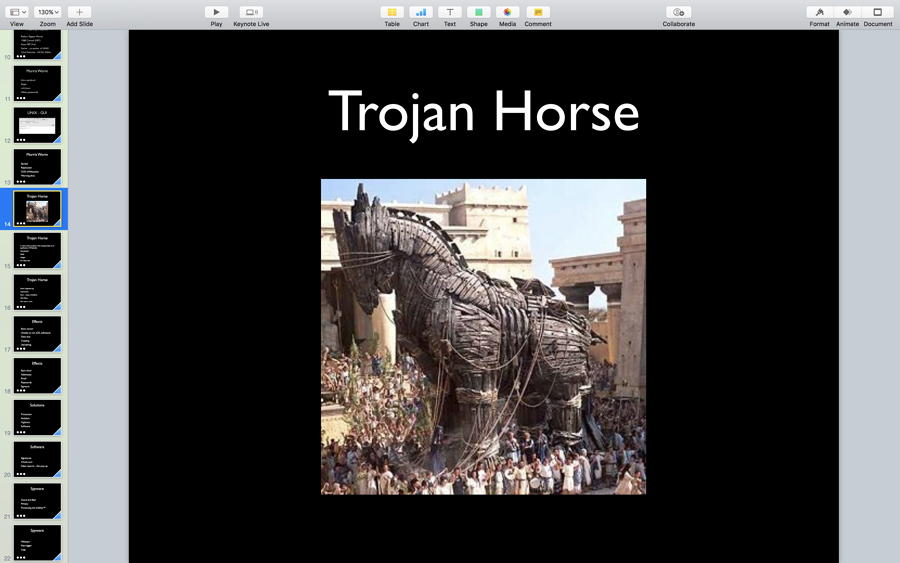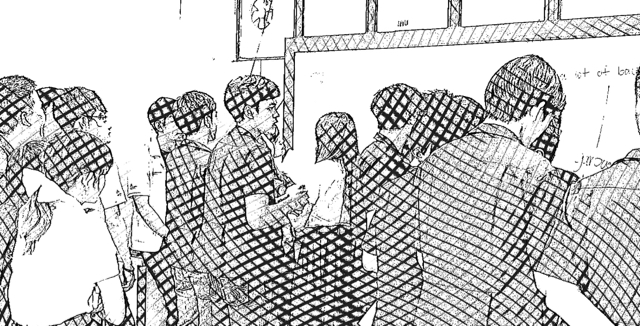Cassandra: Abdication of Responsibility - The Overuse of Presentation Software in Teaching

eXtensions - Thursday 9 March 2017
|
Cassandra: Abdication of Responsibility - The Overuse of Presentation Software in Teaching |
 |
|
|
By Graham K. Rogers
Similar to the experiences of Smith, one of my best lecturers was the head of English at Loughborough University, John Lucas, who used to stroll into a room with a cup of coffee and a small cigar, sit down and just talk. The course I enjoyed most was his Modern Moments. It looked at society and literature from the end of WW1 and examined the zeitgeist: from politics to poetry. He was a strong left-winger in the style of Tony Benn, but his style was urbane and the arguments were persuasive. I have always liked his ideas and his teaching style. At high school one of my strong influences had a different approach. Mr Farley entered every class and, without saying a word, wrote all the notes for the class on the chalkboard: top left to bottom right. If he needed more space, he would start by erasing the top lines and starting again. We all had to keep up with him, writing in our notebooks as we went. Once he had done, it was time for discussion and questions, which was enlivened by his tremendous stammer caused (it was rumoured) by his having been the tail gunner in a Wellington bomber during WW2. I passed the O-level with a reasonable grade and still wonder why I did not continue with the A-level exam. I am not alone in my admiration as one who preceded me by a few years was Sir Ronald Cohen who mentioned Farley as a great influence when he was at the same school.
These days there is hardly a presentation I see that is not tightly scripted: a straightjacket that restricts the speaker. In the case of students defending project work, this learned script may cause them problems returning to the theme if someone interrupts with a question. And when they forget of course. I try to teach students not to rely on memory, because memory can fail. I explain that when I make a presentation, I am making up all the words as I speak. I am never sure if they believe me. While I do have presentations ready for a number of subjects, the slides are more for my guidance and have sparse information for the students to jot down. If they do this, they are not concentrating on what is being said: bullet points are a distraction they do not need. Earlier this week I talked to a class on Ethics & Morals about malware: viruses; worms (focussing on the Morris Worm); the Trojan Horse; and spyware, including keyloggers, also referencing parental controls. I have some pictures - the one on the Trojan Horse was taken from an old movie - some major points, but the most important information is not on paper, nor on the slides. Of particular importance in the information was the addition of overnight revelations about a Wikileaks release and spyware on devices. With slides focused only on main points, I have the freedom to digress if needed.

In his book that mainly focuses on the iPhone introduction, The Presentation Secrets of Steve Jobs, Carmine Gallo outlines the steps needed for an effective presentation, but an examination of many of these could be applied to effective teaching: the most important being knowledge and rehearsal. When I teach presentation skills I make a point by selecting a student from the back of the class and asking him (easier for a male teacher to pick on male students) to make a brief presentation on Thailand's Nuclear Energy Program. A combined shudder and laugh goes round the class and the student's smile disappears. Some try, but after a few moments I release the victim and ask the class what the problem was. It is clear immediately that a lack of knowledge makes this extremely hard. In subsequent weeks I build with random presentations (sun, moon, Kerchoff's Law and others), followed by asking the students to research those random subjects for better output, before they make class presentations that carry marks. I teach this stuff, because the students have to make presentations and many simply follow their teachers who lecture: teach with slides. This is not presentation.
Before I went into the Police force, and long before university, I worked for a news distribution company. I was sent to Brighton for a couple of weeks' practical training and that meant going to work around 3:30 am when the newspaper train came in from London. For part of the time I was there, the Trades Union Congress had its annual conference. I came down for breakfast one morning at 3am to see the fiery trades' union leader (VP of the National Union of Mineworkers), Mick McGahey discussing the working classes and history with one of the night porters. Along with his knowledge there was a sense of passion as he outlined his ideas. That "messianic sense of purpose" is mentioned by Gallo as one of the strengths behind Steve Jobs' best presentations. This has also been called a reality-distortion field by others, but that should be what teaching is: infecting others with our ideas not because it is part of the job description, but because we feel that is what we want to do.

The students expect to find the presentations online, which reduces the need for them to pay attention in class, for example by taking notes. Unless there is some effective way to check on student understanding, there is little need for students to look at these materials until exam time and then they wonder why their grades are lower. The real losses here are not lower grades, but in knowledge and understanding. While there are real circumstances in which the use of slide presentations does have a value and a legitimate purpose, relying on such a medium as the main method of teaching, diminishes the role of teachers and turns them into mere messengers. We should be in the business of helping students to understand, not showing them how clever we are. When new ideas are put forward they are sometimes met with sweeping rejections like "Not suitable for our students" or "We tried this and it didn't work". My interpretations of these suggest they may be better expressed as "Not suitable for me" and "I tried that and couldn't make it work" which is all the more galling as novel methods do work when the will of the teacher is there. Such fossilized thinking is unlikely to change in the short term, but those who obstruct innovation in teaching should be put on notice: like it or not, change is coming. It is time to rethink those boring slides.
Graham K. Rogers teaches at the Faculty of Engineering, Mahidol University in Thailand. He wrote in the Bangkok Post, Database supplement on IT subjects. For the last seven years of Database he wrote a column on Apple and Macs. He is now continuing that in the Bangkok Post supplement, Life. He can be followed on Twitter (@extensions_th) |
|

For further information, e-mail to
Back to
eXtensions
Back to
Home Page